Chess was played by cable in the 19th century because… well, why not? And because everything old is new again, 2021 has brought us ‘Hybrid chess’, in which players play online, but congregate in hubs shared with other players under the supervision of an arbiter. This time, put it down to human frailty and our need to visit the loo.
In a time when a smartphone will suggest moves to beat the world champion, competitive online chess relies on the watchful eye of a webcam to deter casual cheating when people play from home. For that reason, online games are overwhelmingly played at rapid and blitz time controls, because when games last less than 40 minutes, it is reasonable to require that players remain at their desk throughout.
But there remains a strong appetite for classical chess where games can last for hours. Nobody wants a webcam in their bathroom at home and international travel remains, at best, impractical. So it came to be that this year’s European Individual Championship was one of the first major hybrid events.
In the first knockout round, England’s Ravi Haria scored an impressive 2-0 upset against a German grandmaster. Here is the first game from that match — a magnificent demonstration of the power of two bishops.
Falko Bindrich–Ravi Haria
European Individual Championship Hybrid,
May 2021
1 c4 e6 2 g3 d5 3 Bg2 Nf6 4 Nf3 Be7 5 O-O O-O 6 b3 b6 7 Bb2 Bb7 8 e3 c5 9 d3 Qc8 10 Nbd2 Nc6 11 Qe2 Qc7 12 a3 Rad8 13 Rad1 Rfe8 14 Ne1 e5 15 f4 exf4 16 gxf4 d4 17 e4 Bd6! An excellent idea, inviting the fork which follows. 18 e5 Nxe5! At a stroke, all the Black pieces spring to life 19 fxe5 Rxe5 20 Ne4 Nxe4 21 Bxe4 Qe7 22 Nf3 22 Qf3! was a sturdier defence, when 22…Bxe4 23 dxe4 Rxe4 leaves Black standing comfortably, with three pawns for the knight. I would also be tempted to keep that formidable bishop with 22…Rxe4 23 dxe4 Bxe4. 22…f5! Raising the stakes! 23 Nxe5 fxe4 24 Rf7 At first glance 24 Ng4 looks safer, but after 25… e3 it turns out that White is hopelessly lost in spite of the extra rook. For example, if 25 Rf5 Qh4 26 Rdf1 Bxh2+! 27 Nxh2 Qg3+ and mate next move. 24…Qg5+ 25 Qg2 Qxg2+ 26 Kxg2 Ba8! So strong are the bishops that the Black attack continues even without queens on the board. 27 Rf5 g6 28 Rg5 e3+ 29 Kg1 Re8 30 Ng4 30 Nxg6 hxg6 31 Rxg6+ Kf7 32 Rxd6 Rg8+ 33 Kf1 Rg2! and Black’s threats include Rxb2, e2+ and the construction of a mating net with Bf3 and Rg2-h2-h1. 30…Bf4 31 Nf6+ Kf7 32 Nxe8 (see diagram) e2!! Stunning, and much stronger than capturing on g5, which allowed 33 Ne8-d6+ and Nd6-e4. Now if 33 Re1 Be3 is mate, so White loses both rooks. 33 Rf1 exf1=Q+ 34 Kxf1 Bxg5 35 Nc7 Bc6 36 Nb5 a6 White soon sheds further material e.g. 37 Nc7 Bf4 38 Nxa6 Bb7 so White resigns
Got something to add? Join the discussion and comment below.
Get 10 issues for just $10
Subscribe to The Spectator Australia today for the next 10 magazine issues, plus full online access, for just $10.
You might disagree with half of it, but you’ll enjoy reading all of it. Try your first month for free, then just $2 a week for the remainder of your first year.

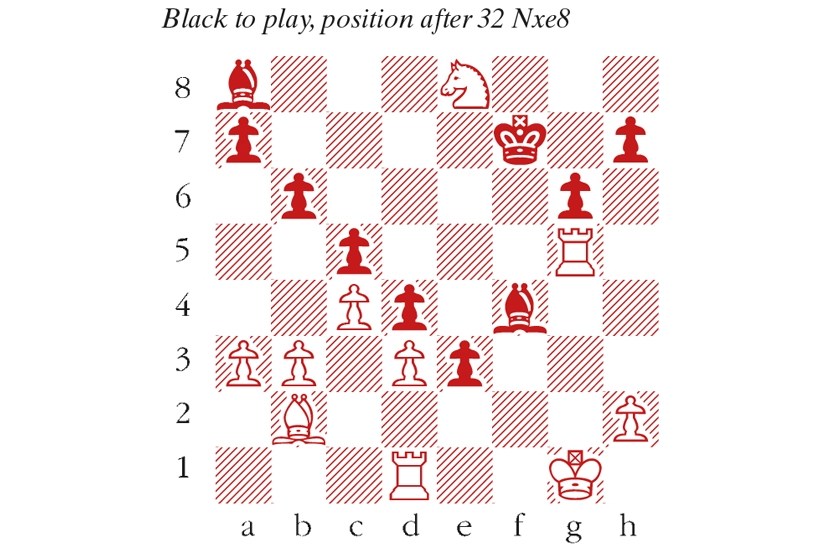
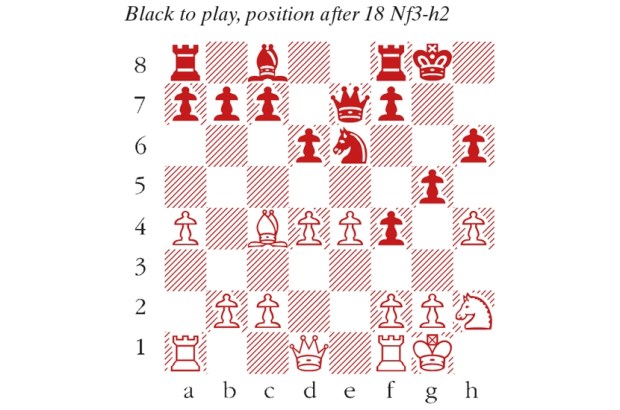
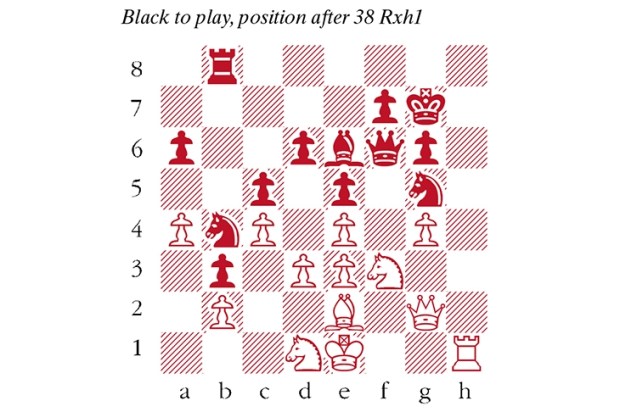
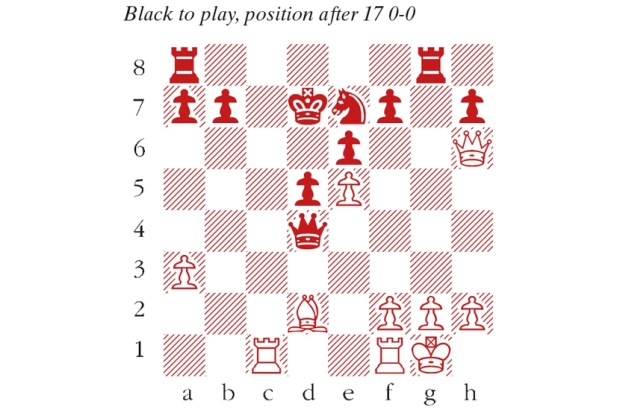
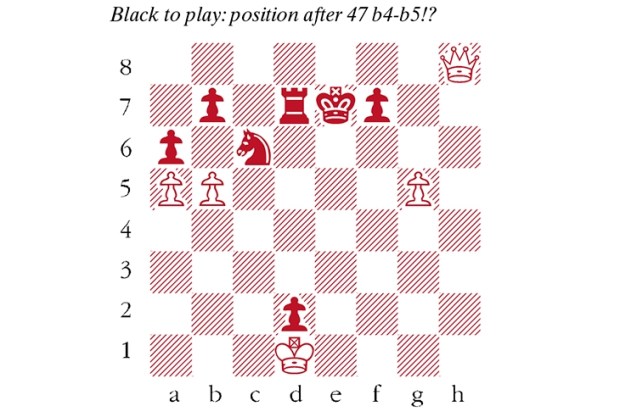
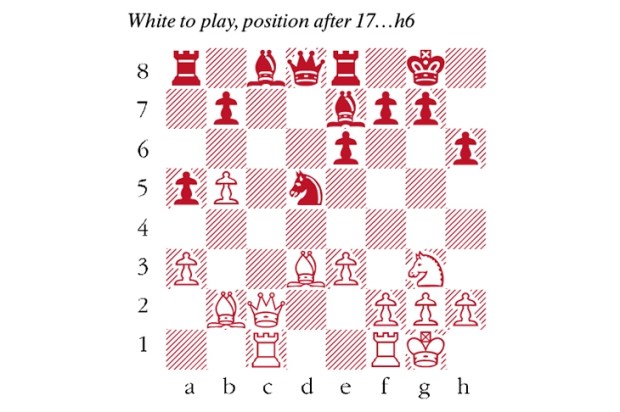
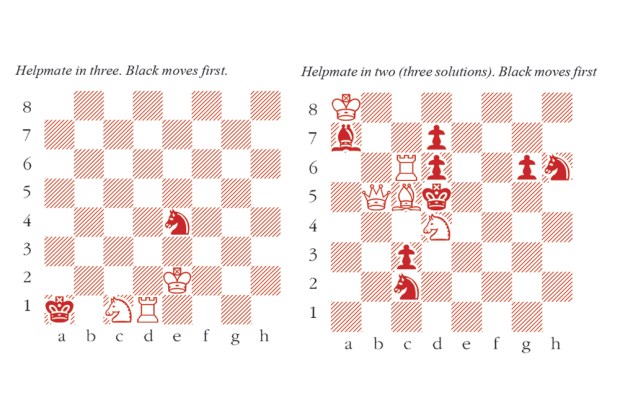






Comments
Don't miss out
Join the conversation with other Spectator Australia readers. Subscribe to leave a comment.
SUBSCRIBEAlready a subscriber? Log in